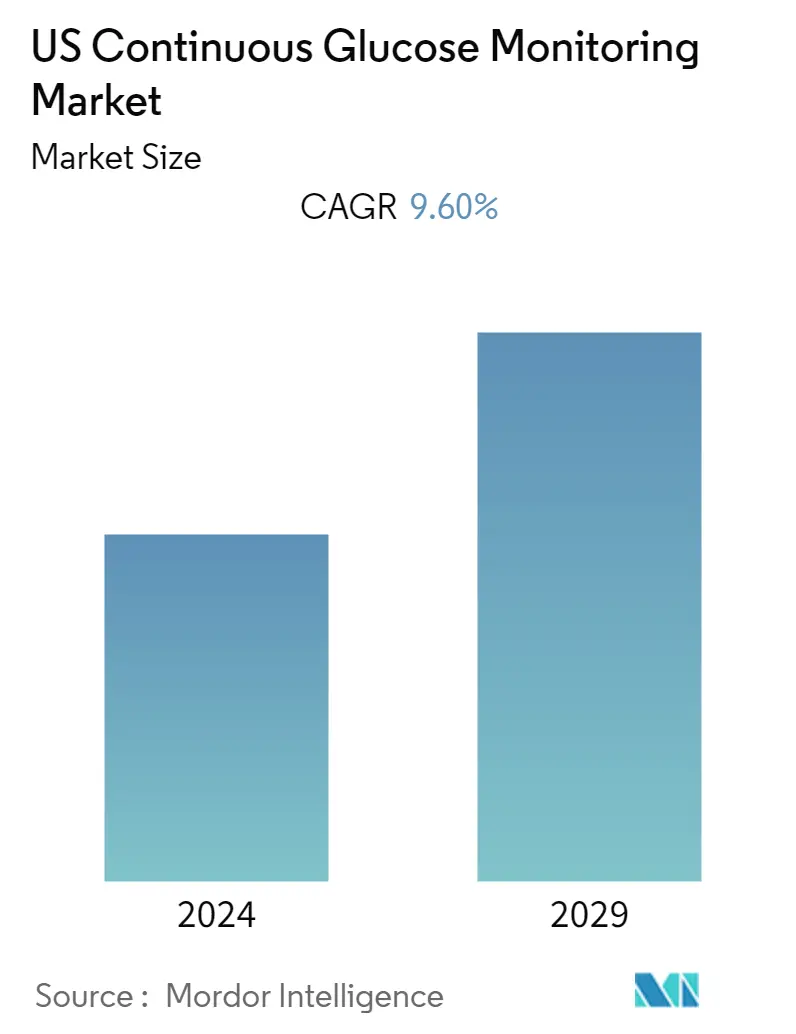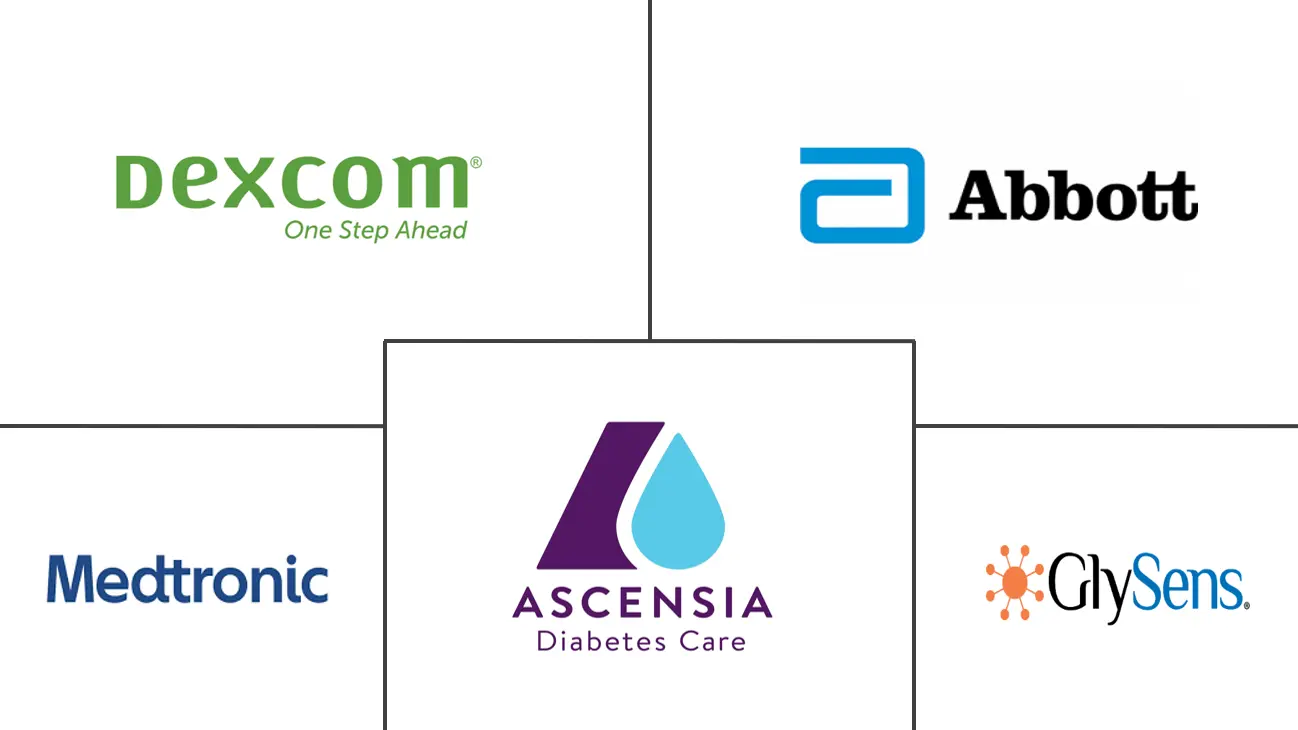Market Size of US Continuous Glucose Monitoring Industry

| Study Period | 2019 - 2029 |
| Base Year For Estimation | 2023 |
| Forecast Data Period | 2024 - 2029 |
| Historical Data Period | 2019 - 2022 |
| CAGR | 9.60 % |
Major Players
*Disclaimer: Major Players sorted in no particular order |
US Continuous Glucose Monitoring Market Analysis
The United States Continuous Glucose Monitoring Market is expected to register a CAGR of 9.6% over the forecast period.
During the COVID-19 pandemic, patients with diabetes were at higher risk for hospitalizations and complications due to hyper- or hypoglycemia, metabolic comorbidities, and more severe illness from SARS-CoV-2 infection. The maintenance of euglycemia was important to decrease both morbidity and mortality in the hospital setting. The Food and Drug Administration (FDA) allowed the use of CGM devices in the inpatient setting in response to the COVID-19 pandemic. According to experts, inpatient use of diabetes technology in patients with proper institutional protocols was safe and improved inpatient glycemic outcomes and played a vital role in managing hypoglycemia and hyperglycemia in hospitalized patients.
Appropriate and timely monitoring of blood glucose allows the successful management of out-of-range blood glucose levels, minimizing diabetic-related health complications. Continued elevation in blood glucose levels in diabetes patients can contribute to progressive complications such as renal, nerve, and ocular damage. The measurement of blood glucose helps in determining the effectiveness of blood glucose metabolism and guides in achieving optimal glucose control within the body. Over time the readings provide the patient and their health professionals with the information required to determine the best management strategy for diabetes.
According to National Centre for Health Statistics, about 32.8% of adults aged 18 and over had obesity in 2021 in the United States. In obese individuals, the fat cells in the body release pro-inflammatory chemicals, which may make the body less sensitive to the insulin it produces by disrupting the function of insulin-responsive cells. Thus, these individuals need external insulin shots and are obligated to use a Continuous Glucose Monitoring device.
Furthermore, the current continuous glucose Monitoring can either retrospectively display the trends in the levels of blood glucose by downloading the data or give a real-time picture of glucose levels through receiver displays. The newest CGM models, the Abbott Freestyle Libre 3 and the Dexcom G7, overcame many technical barriers. Technological advances such as Eversense E3 CGMs have significantly improved the ability of providers and patients to manage diabetes, thereby enhancing the market prospects in the years to come.
US Continuous Glucose Monitoring Industry Segmentation
Achieving optimum glycemic results can be very difficult without frequent monitoring of blood glucose levels. A continuous glucose monitor tracks blood sugar levels 24 hours a day. It collects readings automatically every five to 15 minutes and detects trends and patterns to provide a complete picture of diabetes. The United States Continuous Glucose Monitoring Market is segmented into Components (Sensors and Durables (Receivers and Transmitters)). The report offers the value (in USD million) and volume (in Units million) for the above segments.
| Component | |
| Sensors | |
| Durables |
US Continuous Glucose Monitoring Market Size Summary
The United States Continuous Glucose Monitoring (CGM) market is poised for significant growth, driven by the increasing prevalence of diabetes and obesity-related conditions. The market is characterized by technological advancements in CGM devices, such as the Abbott Freestyle Libre 3 and Dexcom G7, which have enhanced the management of diabetes by providing real-time glucose level monitoring. The COVID-19 pandemic highlighted the importance of maintaining euglycemia, leading to the FDA's approval for CGM use in inpatient settings, thereby improving glycemic outcomes for hospitalized patients. The rising diabetes population, influenced by lifestyle changes and socioeconomic factors, underscores the need for effective glucose monitoring solutions, further propelling market expansion.
The market landscape is consolidated, with key players like Abbott, Dexcom, and Medtronic driving innovation through mergers, acquisitions, and substantial R&D investments. The sensors segment, crucial for CGM functionality, is expected to experience robust growth due to advancements in accuracy and the development of alternative sensing technologies. The integration of CGMs into primary health services and the focus on social determinants of health by organizations such as the American Diabetes Association and the World Health Assembly are expected to enhance access and adoption. These factors, combined with the supportive regulatory environment and emerging evidence of CGM benefits, are set to bolster the market's growth trajectory over the forecast period.
US Continuous Glucose Monitoring Market Size - Table of Contents
-
1. MARKET DYNAMICS
-
1.1 Market Overview
-
1.2 Market Drivers
-
1.3 Market Restraints
-
1.4 Porter's Five Forces Analysis
-
1.4.1 Bargaining Power of Suppliers
-
1.4.2 Bargaining Power of Consumers
-
1.4.3 Threat of New Entrants
-
1.4.4 Threat of Substitute Products
-
1.4.5 Intensity of Competitive Rivalry
-
-
-
2. MARKET SEGMENTATION
-
2.1 Component
-
2.1.1 Sensors
-
2.1.2 Durables
-
-
US Continuous Glucose Monitoring Market Size FAQs
What is the current US Continuous Glucose Monitoring Market size?
The US Continuous Glucose Monitoring Market is projected to register a CAGR of 9.60% during the forecast period (2024-2029)
Who are the key players in US Continuous Glucose Monitoring Market?
Abbott Diabetes Care, Dexcom Inc., Ascensia Diabetes Care, Medtronic and GlySens are the major companies operating in the US Continuous Glucose Monitoring Market.

